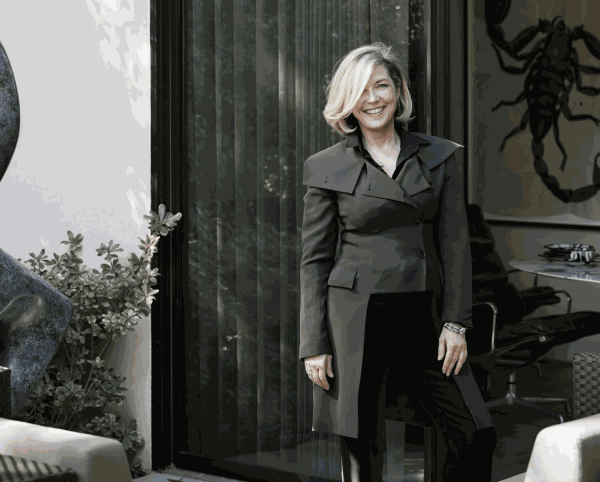Damien Hirst
Damien Hirst was born in Bristol in 1965. He studied at Goldsmiths College in London and first came to public attention in 1988 when he conceived and curated "Freeze," an exhibition of his work and that of his friends and fellow students at Goldsmiths. In the near quarter century since that pivotal show, Hirst has become one of the most prominent artists of his generation. Many of his works are widely recognized, from the shark suspended in formaldehyde, The Physical Impossibility of Death in the Mind of Someone Living (1991) and his spot, spin and butterfly paintings, through to later works such as the diamond skull For the Love of God (2007).
Hirst's paintings can be seen as a foil to his sculptural work, though they are similarly inconclusive. The 'spot' paintings are named after pharmaceutical stimulants and narcotics, the chemical enhancers of human emotion, and yet take the form of mechanical and unemotional Minimalist paintings. Their detachment is further emphasised by the exploitation of procedures that can be simply carried out by assistants under his instruction. Hirst's interest in contemporary society is further reflected in collaborative pop music projects and in his designs for the Pharmacy and Quo Vadis restaurants, London. He was awarded the Turner Prize in 1995.
-
 Damien Hirst1-Diazo-4-Benzoylamino-2,5-Diethoxybenzene, 2022Household gloss on canvas45 by 45 inches
Damien Hirst1-Diazo-4-Benzoylamino-2,5-Diethoxybenzene, 2022Household gloss on canvas45 by 45 inches -
 Damien Hirst5-Diazouracil, 2022Household gloss on canvas39 by 63 inches
Damien Hirst5-Diazouracil, 2022Household gloss on canvas39 by 63 inches -
 Damien HirstSuiko (The Empresses), 2022Laminated Giclee print on aluminium composite,
Damien HirstSuiko (The Empresses), 2022Laminated Giclee print on aluminium composite,
screen printed with glitter39 2/5 by 39 2/5 inchesEdition of 3310 -
 Damien HirstHands in Prayer (Coral), 2021Bronze12 by 6 by 7 inchesEdition 2 of 3
Damien HirstHands in Prayer (Coral), 2021Bronze12 by 6 by 7 inchesEdition 2 of 3 -
 Damien HirstEternal Beauty (Amber crystal), 2015Lalique CrystalSold
Damien HirstEternal Beauty (Amber crystal), 2015Lalique CrystalSold -
 Damien HirstEternal Beauty (Turquoise crystal, platinum stamped), 2015Lalique CrystalSold
Damien HirstEternal Beauty (Turquoise crystal, platinum stamped), 2015Lalique CrystalSold -
 Damien HirstAstrotia Stokesii, 2008Household gloss on canvas155 x 104 cm
Damien HirstAstrotia Stokesii, 2008Household gloss on canvas155 x 104 cm
61 x 41 inches -
 Damien HirstChaos, 2008Butterflies and household gloss on canvas36 by 36 inches
Damien HirstChaos, 2008Butterflies and household gloss on canvas36 by 36 inches
91 by 91 cm -
 Damien HirstPsalm 66: Jubilate Deo, 2008Butterflies and household gloss on canvas18 by 18 inchesSold
Damien HirstPsalm 66: Jubilate Deo, 2008Butterflies and household gloss on canvas18 by 18 inchesSold
46 by 46 cm
-
 Damien HirstWonderful Day, 2008Butterflies and household gloss on canvas72 x 72 inchesSold
Damien HirstWonderful Day, 2008Butterflies and household gloss on canvas72 x 72 inchesSold -
 Damien HirstCoral Love, 2007Butterflies and household gloss on canvas68 by 68 inches
Damien HirstCoral Love, 2007Butterflies and household gloss on canvas68 by 68 inches -
 Damien HirstSinful, 2007Butterflies and household gloss on canvasUnframed: 48 1/2 x 95 3/4 inches
Damien HirstSinful, 2007Butterflies and household gloss on canvasUnframed: 48 1/2 x 95 3/4 inches
Damien Hirst (b. 1965) is one of the most influential artists of his generation, exploring the intersections of art, science, religion, and mortality through sculpture, installation, painting, and drawing. Rising to prominence in the late 1980s, he first captured attention while studying at Goldsmiths College by organizing Freeze (1988), a pivotal exhibition that launched the Young British Artists (YBAs) and defined a new era of British contemporary art.
Hirst’s practice challenges perceptions of beauty and belief, whether through his iconic Spot Paintings—vibrant grids of colored circles exploring color and repetition—or his Natural History series, featuring preserved animals in tanks of formaldehyde, including the famed tiger shark work The Physical Impossibility of Death in the Mind of Someone Living(1991). Other notable projects include his medicine cabinet installations, butterfly paintings, and the diamond-encrusted skull For the Love of God (2007), each examining human desire, mortality, and the promises of modern consumption.
Hirst’s ambitious projects have included the butterfly-filled In and Out of Love (1991) and the immersive Treasures from the Wreck of the Unbelievable (2017) in Venice, demonstrating his commitment to creating art that is both conceptually rigorous and visually striking. He has exhibited widely, including retrospectives at Tate Modern and the Museo Archeologico Nazionale in Naples, and in 2015 he opened Newport Street Gallery in London to share his collection with the public.
-

Damien Hirst at 60: My plan to make art for 200 years after I die
In a rare interview, the artist talks about making money, being a dad again — and his most outrageous scheme yet, ‘posthumous paintings’ The Times Read more -

Damien Hirst at Albertina Modern
July 8, 2025 Read more -

Where Don Draper, Jude Law and Damien Hirst Live in Dallas
THIS STUNNING PRESTON HOLLOW HOME IS FULL OF MODERN WONDERS — AND STORIES GALORE April 11, 2018PAPERCITY MAGAZINE HOME + DESIGN / DESIGN NOTES By Rebecca Sherman / 04.10.18 Photography Pär Bengtsson Damien Hirst’s “Psalm 126: In convertendo”, 2008, and Polly...Read more
















